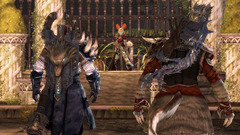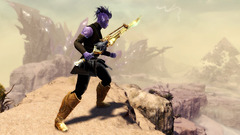If the first narrative season of MMORPGs Guild Wars 2 was an ephemeral experience, disappearing over time to make the persistent world alive and evolving, the studio ArenaNet quickly realized that much of the developed content was disappearing at the same time. This error will not be reproduced from season 2, but it will have been necessary to wait nine years before being able to (re) discover the genesis of the story of Guild Wars 2, including the emblematic confrontation with Scarlet Bruyère, the sylvari credited with destroying Lion’s Arch.
Like the other Season 1 episodes released this year, “Mechanical Chaos” will pack the majority of the original 2013 experience into one narrative episode, while adding new rewards, like “Mechanical Sentry Strikes and the “Pavilion Champion’s Wolfblade”, a sword modeled after the mechanical knights of the Queen’s Jubilee.
The version of the game that accompanies this installment also features updates to some of the world boss fights from Guild Wars 2’s core areas. Svanir Shaman and Fire Elemental will be updated to bring these events up to current standards. In addition, the model of some of these bosses will receive visual improvements.
At the same time, Didji and I had the opportunity to ask questions to members of the team working on the first season.
Looking back on the first season of Living World, are there things you would have done differently if you had to do them again today?
Joe Kimmes, team manager on season 1: The re-release of season 1 changes the structure of updates to linear episodes, and that in itself is the first part of my answer – changing the season so players can play it anytime and come back to it for get achievements and rewards. We have had the opportunity to make these changes, but if we had to start from scratch, it would be possible to foresee it from the start.
When it comes to Episodes 2 and 3 in particular, many of the Season 1 updates were tightly tied to festivals. The Dragon Bash, Queen’s Jubilee, and even Halloween were tied into the story during Season 1, which created some debt for the future, both to revive these festivals as annual events and to restore story content in an environment where the festival may not be active when players are playing the story.
Indigo Boock, head of storytelling on season 1 : As a writer, it’s hard not to look at past work and not want to redo it. It is a very difficult exercise. Players who were lucky enough to play Season 1 when it first released have very strong memories of this content; it sparks nostalgia, and we didn’t want to ruin that. Even if we were to rebuild the game from scratch, we would like to keep what it was when it was initially released. But, we had the opportunity to condense parts of the story this time around. It wasn’t originally meant to be played in a linear fashion, so we’ve been looking to make sure it fits in the Chronicles.
When we started rebuilding season 1, Joe, Bobby [ndlr: Bobby Stein, Directeur narratif] and I discussed whether to bring back some of the actors to rework parts of the story. For Clockwork Chaos (and subsequent episodes), we had a unique opportunity to bring Tara Strong back into the cabin to refresh some of Scarlet’s voice.
His story arc would eventually make waves throughout the rest of Guild Wars 2’s story, so we’ve taken the opportunity to add a handful of new audio logs that give a fresh perspective on his interior. We also revisited a handful of critical moments to make sure his presentation to the Commander was as terrifying as it was thrilling. This way, we were able to retain the experience players had when they first played this content, but new viewers were able to come away with a better understanding of Scarlet’s story arc. There are so many things we would have liked to do, but I think the adjustments we were able to make will have an equally strong impact.
How is the process of creating a Living World episode different now than in Season 1?
Joe Kimmes : Back in the days of Season 1, content was being developed at a very rapid pace; we had different production plans and a lot of the content was done just in time to meet the release schedule. After a few years of experience, recent episodes have been created with much more time for early planning and are bundled into a single update, rather than aiming to release sequential episodes every few weeks.
How much of the work you did back then is reused when re-editing episodes today?
Joe Kimmes: Almost all of the original work has been reused in one way or another. Here and there we removed some elements or moved them to make it a kind of “director’s cut”, but everything is built on the basis of the original. Luckily, we didn’t have to completely recreate the original episodes. In fact, the demonstration that Season 1 content could be restored without having to rebuild everything through the Visions of the Past missions and the Wicked Puppet event was a significant step forward that made this restoration possible.
Do you plan to make the story dungeons (Fusion Alliance Weapons Factory, Aetherblade Refuge, and Scarlet’s Hideout for the next episode) available as normal dungeons, so players can repeat them easily?
Joe Kimmes : The Fusion Alliance Weapons Factory and Aetherblade Refuge remain replayable as Fractals of the Mists, so we consider these to be the definitive incarnations of these missions for the top level. Scarlet’s Hideout was never a real dungeon and hasn’t been picked as a Fractal over the years, but I’ll be watching player reactions to it closely. We’ve tweaked it a bit to be closer to the norm for a dungeon or fractal, and while it’s not officially planned yet, it could happen.
What made you go from “placing Living World episodes in existing maps” in seasons 1 and 2 to “creating a new map for each episode” starting in season 3?
Joe Kimmes: With hindsight, this change was more gradual than it appears today. The first Living World-like outing was the “Lost Shore” event which took players to the new Southsun Cove map, and while Season 1 itself didn’t add any permanent maps to the open world, areas like the Labyrinthine Cliffs and the Crown Pavilion were major places to explore. Season 2 added Dry Top and the Silver Wilds as it updates, with each area opening up a bit more each episode to become the full maps all players have access to today.
Basically, the heart of the problem was time. It takes a long time to create a complete map with the entire development team, including map art, new environment models and assets, sounds and background music, and of course, adding events and creatures. Throughout Seasons 1 and 2, different approaches were used for map size, content density, and the number of updates that affected both new and old maps.
By Season 3, we had a lot of information about our ability to create new areas and what players were most excited to see, which led to the approach that most episodes include a new map and focus their content and storyline there.
Can you tell us the players’ favorite seasons or episodes?
Joe Kimmes : We collect a lot of metrics from the game, but it’s a science to determine the favorites – especially since sometimes the stars align and a particular moment hits the mark. In the original Season 1, updates meant to improve champion loot were released alongside waves of champion enemies during the Scarlet Invasions, much to the delight of players (and the dismay of some). economic spreadsheets). I don’t know if the remastered version will fully capture this moment, but hopefully it does justice to the fond memories players have of those battles!
Thank you for your answers !
.
The post Guild Wars 2 – Return of Clockwork Chaos and Scarlet to Guild Wars 2, Season 1 Developer Interview appeared first on Gamingsym.


